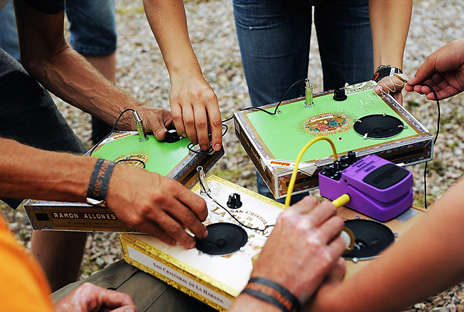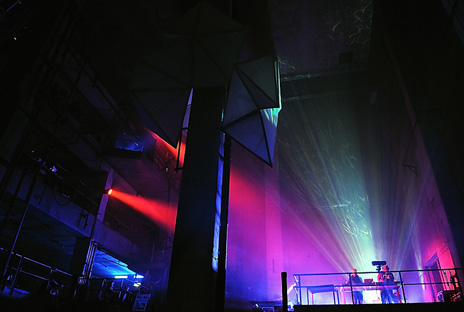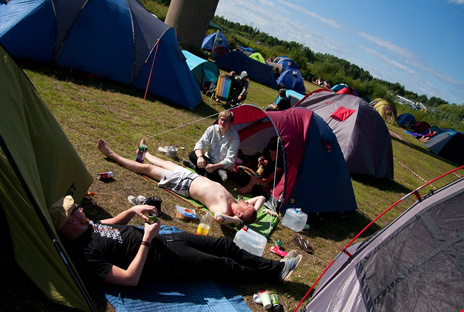- "In the forest, you need to learn how to improvise," said one of the organizers of Norberg festival while clearing off a table in preparation for an electromagnetic sound performance that opened the event. Right after the performance by Zenial—magnifying the usually unheard sounds of a mobile phone, chair cover, camera and other household objects—I spotted an "I heart hard techno" t-shirt in the audience. Then someone resembling a character from The Matrix, and a very normal looking family with toddlers in tow.
 Photo credit: Christian Olofsson
This mix of rustic backdrop, casual attitude, modernism, technical experimentation and an assortment of patrons of all shapes and sizes made for a unique festival experience. Described by the festival as showcasing "electronic music, sound art and clubs," there was enough programming through the four main venues to facilitate strikingly different music throughout the festival's three days, making Norberg as amorphous and indefinable as some of the sound art showcased.
Photo credit: Christian Olofsson
This mix of rustic backdrop, casual attitude, modernism, technical experimentation and an assortment of patrons of all shapes and sizes made for a unique festival experience. Described by the festival as showcasing "electronic music, sound art and clubs," there was enough programming through the four main venues to facilitate strikingly different music throughout the festival's three days, making Norberg as amorphous and indefinable as some of the sound art showcased.
 Photo credit: Pia Hammar
So, why stage a festival in Norberg, Sweden, a town of around 5,000 inhabitants and at least two-and-half hour drive from Stockholm? Well, one of the most special and central aspects of the event is its location—a former mine. Around this, the surrounding Mimerlaven area holds a small campsite, all four venues, a bar and eating area and is nestled within a nice wooded region for some between-set exploring. The main venue—the aforementioned mine—was closed in 1980 and gutted shortly after, allowing for it to now be transformed during the festival into an acoustic wonderland for sound artists.
Photo credit: Pia Hammar
So, why stage a festival in Norberg, Sweden, a town of around 5,000 inhabitants and at least two-and-half hour drive from Stockholm? Well, one of the most special and central aspects of the event is its location—a former mine. Around this, the surrounding Mimerlaven area holds a small campsite, all four venues, a bar and eating area and is nestled within a nice wooded region for some between-set exploring. The main venue—the aforementioned mine—was closed in 1980 and gutted shortly after, allowing for it to now be transformed during the festival into an acoustic wonderland for sound artists.
 Photo credit: Peo Bengtsson
With speakers rigged at every possible angle this towering concrete barracks was a perfect environment for Jonathan Liljedahl's drone-heavy performance to fill the space, but also for the crystal purity and brute force of Derek Holzer's nail-on-chalkboard sounds to shine (figuratively of course) as well. Visuals were also prominent in the space, with strategic lighting, wall-sized projections and illuminated objects.
Photo credit: Peo Bengtsson
With speakers rigged at every possible angle this towering concrete barracks was a perfect environment for Jonathan Liljedahl's drone-heavy performance to fill the space, but also for the crystal purity and brute force of Derek Holzer's nail-on-chalkboard sounds to shine (figuratively of course) as well. Visuals were also prominent in the space, with strategic lighting, wall-sized projections and illuminated objects.
 Photo credit: Christian Olofsson
Beside the mine was another part of the complex called the 8-channel Room, a less foreboding space that featured experimental electronic works. On Saturday night, Leo Correia De Verdier and her Br LS-2125's sewing machine and sequencers stole the show, with around forty audience members watching her sew sounds. Then satiating the "electronic music" tip, the Buchla boys from Gothenburg performed a forty-minute live synthesized techno set using old modular systems. Dancing actually did ensue in the otherwise more academic space.
Kraftwork—an old barn building—hosted acts like acid house pros Hardfloor and Skinnerbox, and was also was home to Morning Ambient from 10 AM to 1 PM, which provided soothing sounds and free fruit. Camp 303 was the only tented space, and hosted the likes of Jasper Dahlback, Dungeon Acid, Bacid and Kettel.
Photo credit: Christian Olofsson
Beside the mine was another part of the complex called the 8-channel Room, a less foreboding space that featured experimental electronic works. On Saturday night, Leo Correia De Verdier and her Br LS-2125's sewing machine and sequencers stole the show, with around forty audience members watching her sew sounds. Then satiating the "electronic music" tip, the Buchla boys from Gothenburg performed a forty-minute live synthesized techno set using old modular systems. Dancing actually did ensue in the otherwise more academic space.
Kraftwork—an old barn building—hosted acts like acid house pros Hardfloor and Skinnerbox, and was also was home to Morning Ambient from 10 AM to 1 PM, which provided soothing sounds and free fruit. Camp 303 was the only tented space, and hosted the likes of Jasper Dahlback, Dungeon Acid, Bacid and Kettel.
 Photo credit: Christian Olofsson
While there was an array of sound art and music to consume, Norberg is still very niche and within a very small site, so ensuring that most of the music showcased is of at least some interest is key. While you can select the events you commit to, you are still very much in the middle of it all—and exposed to a lot of sound bleeding from tent to tent as a result.
At times it was a bit much to exit the drones of the mine and be thrown directly into an acid techno set. That said, Norberg festival occupies a special space where dance and experimental electronic music are in mostly harmonious union. If you want to have a bit of a palette cleanser from more uniformly-produced dance events—or just want to see something new—this may be one to pencil in for next year.
Photo credit: Christian Olofsson
While there was an array of sound art and music to consume, Norberg is still very niche and within a very small site, so ensuring that most of the music showcased is of at least some interest is key. While you can select the events you commit to, you are still very much in the middle of it all—and exposed to a lot of sound bleeding from tent to tent as a result.
At times it was a bit much to exit the drones of the mine and be thrown directly into an acid techno set. That said, Norberg festival occupies a special space where dance and experimental electronic music are in mostly harmonious union. If you want to have a bit of a palette cleanser from more uniformly-produced dance events—or just want to see something new—this may be one to pencil in for next year.
 Photo credit: Christian Olofsson
This mix of rustic backdrop, casual attitude, modernism, technical experimentation and an assortment of patrons of all shapes and sizes made for a unique festival experience. Described by the festival as showcasing "electronic music, sound art and clubs," there was enough programming through the four main venues to facilitate strikingly different music throughout the festival's three days, making Norberg as amorphous and indefinable as some of the sound art showcased.
Photo credit: Christian Olofsson
This mix of rustic backdrop, casual attitude, modernism, technical experimentation and an assortment of patrons of all shapes and sizes made for a unique festival experience. Described by the festival as showcasing "electronic music, sound art and clubs," there was enough programming through the four main venues to facilitate strikingly different music throughout the festival's three days, making Norberg as amorphous and indefinable as some of the sound art showcased.
 Photo credit: Pia Hammar
So, why stage a festival in Norberg, Sweden, a town of around 5,000 inhabitants and at least two-and-half hour drive from Stockholm? Well, one of the most special and central aspects of the event is its location—a former mine. Around this, the surrounding Mimerlaven area holds a small campsite, all four venues, a bar and eating area and is nestled within a nice wooded region for some between-set exploring. The main venue—the aforementioned mine—was closed in 1980 and gutted shortly after, allowing for it to now be transformed during the festival into an acoustic wonderland for sound artists.
Photo credit: Pia Hammar
So, why stage a festival in Norberg, Sweden, a town of around 5,000 inhabitants and at least two-and-half hour drive from Stockholm? Well, one of the most special and central aspects of the event is its location—a former mine. Around this, the surrounding Mimerlaven area holds a small campsite, all four venues, a bar and eating area and is nestled within a nice wooded region for some between-set exploring. The main venue—the aforementioned mine—was closed in 1980 and gutted shortly after, allowing for it to now be transformed during the festival into an acoustic wonderland for sound artists.
 Photo credit: Peo Bengtsson
With speakers rigged at every possible angle this towering concrete barracks was a perfect environment for Jonathan Liljedahl's drone-heavy performance to fill the space, but also for the crystal purity and brute force of Derek Holzer's nail-on-chalkboard sounds to shine (figuratively of course) as well. Visuals were also prominent in the space, with strategic lighting, wall-sized projections and illuminated objects.
Photo credit: Peo Bengtsson
With speakers rigged at every possible angle this towering concrete barracks was a perfect environment for Jonathan Liljedahl's drone-heavy performance to fill the space, but also for the crystal purity and brute force of Derek Holzer's nail-on-chalkboard sounds to shine (figuratively of course) as well. Visuals were also prominent in the space, with strategic lighting, wall-sized projections and illuminated objects.
 Photo credit: Christian Olofsson
Beside the mine was another part of the complex called the 8-channel Room, a less foreboding space that featured experimental electronic works. On Saturday night, Leo Correia De Verdier and her Br LS-2125's sewing machine and sequencers stole the show, with around forty audience members watching her sew sounds. Then satiating the "electronic music" tip, the Buchla boys from Gothenburg performed a forty-minute live synthesized techno set using old modular systems. Dancing actually did ensue in the otherwise more academic space.
Kraftwork—an old barn building—hosted acts like acid house pros Hardfloor and Skinnerbox, and was also was home to Morning Ambient from 10 AM to 1 PM, which provided soothing sounds and free fruit. Camp 303 was the only tented space, and hosted the likes of Jasper Dahlback, Dungeon Acid, Bacid and Kettel.
Photo credit: Christian Olofsson
Beside the mine was another part of the complex called the 8-channel Room, a less foreboding space that featured experimental electronic works. On Saturday night, Leo Correia De Verdier and her Br LS-2125's sewing machine and sequencers stole the show, with around forty audience members watching her sew sounds. Then satiating the "electronic music" tip, the Buchla boys from Gothenburg performed a forty-minute live synthesized techno set using old modular systems. Dancing actually did ensue in the otherwise more academic space.
Kraftwork—an old barn building—hosted acts like acid house pros Hardfloor and Skinnerbox, and was also was home to Morning Ambient from 10 AM to 1 PM, which provided soothing sounds and free fruit. Camp 303 was the only tented space, and hosted the likes of Jasper Dahlback, Dungeon Acid, Bacid and Kettel.
 Photo credit: Christian Olofsson
While there was an array of sound art and music to consume, Norberg is still very niche and within a very small site, so ensuring that most of the music showcased is of at least some interest is key. While you can select the events you commit to, you are still very much in the middle of it all—and exposed to a lot of sound bleeding from tent to tent as a result.
At times it was a bit much to exit the drones of the mine and be thrown directly into an acid techno set. That said, Norberg festival occupies a special space where dance and experimental electronic music are in mostly harmonious union. If you want to have a bit of a palette cleanser from more uniformly-produced dance events—or just want to see something new—this may be one to pencil in for next year.
Photo credit: Christian Olofsson
While there was an array of sound art and music to consume, Norberg is still very niche and within a very small site, so ensuring that most of the music showcased is of at least some interest is key. While you can select the events you commit to, you are still very much in the middle of it all—and exposed to a lot of sound bleeding from tent to tent as a result.
At times it was a bit much to exit the drones of the mine and be thrown directly into an acid techno set. That said, Norberg festival occupies a special space where dance and experimental electronic music are in mostly harmonious union. If you want to have a bit of a palette cleanser from more uniformly-produced dance events—or just want to see something new—this may be one to pencil in for next year.